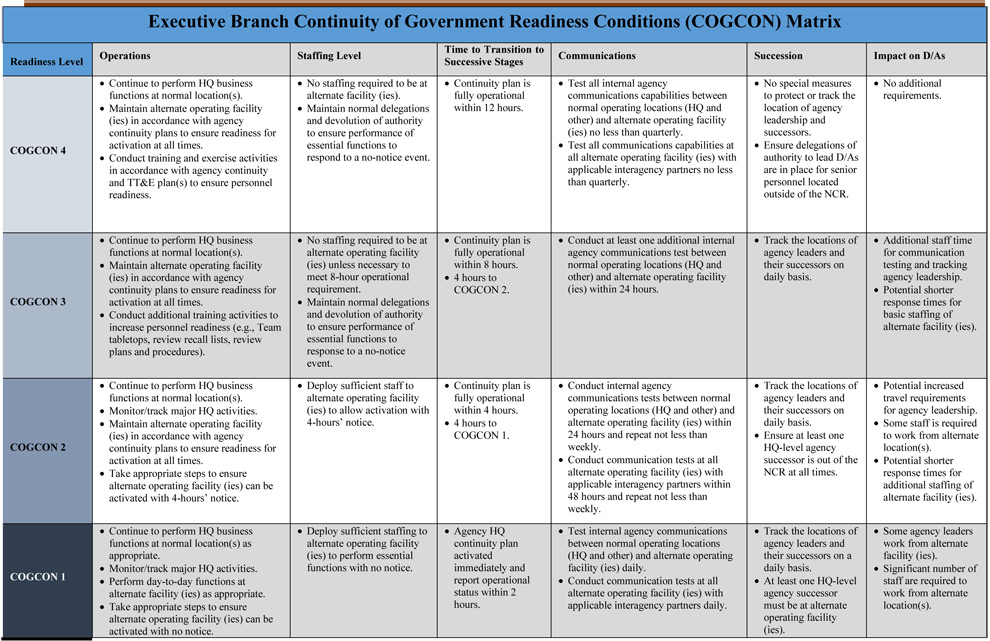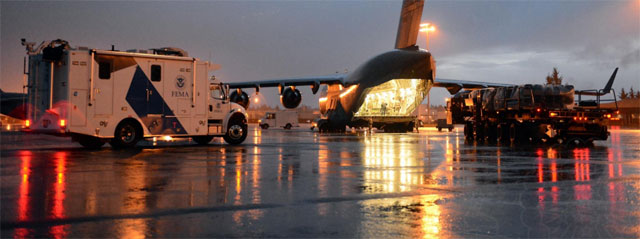Since the days of the Cold War, the United States has had a plan in place to continue the operation of the government following a catastrophic attack on the nation's capital.
The 2007 "National Security Presidential Directive 51" directs the geographic dispersion
of leadership, staff, and infrastructure in order to maintain the functions of the United States Government in the event the nation’s capital is “decapitated” by a terrorist attack.
Buried deep within the 102-page National Continuity Plan is the strategy for the mass evacuation and relocation of every federal government
agency including The White House and the military in response to an exceptional catastrophic event within the National
Capital Region. Each agency is required to have a detailed Continuity of Operations Plan (COOP) in place.
Following a catastrophic national emergency, the President, or his successor can authorize the establishment of a temporary "shadow government" to maintain control of the essential functions
of the Federal Government. President Bush activated the shadow government on September 11, 2001 shortly after the second attack on the World Trade Center.
Every federal agency has designated key individuals to be part of an "Emergency Relocation Group". These ERGs are assigned to an alternate secure location on a rotating basis and are
ready to take over the duty of supporting the National Essential Functions of this nation in an emergency.
The Continuity of Government Readiness Conditions (COGCON) system establishes executive branch readiness levels based on possible threats to the National
Capital Region. The President alone determines and issues the COGCON Level.

View full-size detailed COG Readiness Matrix
When the President directs a COGCON change, all executive departments and agencies are notified:
The National Continuity Policy Implementation Plan identifies eight national essential functions which represent the overarching responsibilities
of the federal government during a crisis.

Evacuating the President
The President would evacuate to the Marine One hangar at the Anacostia Naval Support Facility. His ultimate destination would be onboard the
E-4B National Airborne Operations Center (NAOB), a highly survivable militarized version of the Boeing 747-200
capable of being refueled in flight.
After several days in the air, the President could choose to go to one of the Presidential Emergency Facilities at Mount Weather, Site R, the underground bunker at Camp David,
the bunker at Offutt Air Force Base, the new bunker under the Denver International Airport, or other still-classified locations.
Evacuating the Presidential Line of Succession
The U.S. Northern Command (NORTHCOM) is responsible for evacuating government officials under the guidance of the classified Concept of Operations Plan
CONPLAN 3600: Emergency Preparedness in the National Capital Region. The executive agency and department heads along with designated emergency relocation group (ERG) members would be transported to classified locations around the country above ground, below ground, and
at sea.
The secret evacuation plan includes a nearby fleet of specialized vans and trucks that can be dispatched on a moment's notice
to secret campgrounds located within the Shenandoah Valley and in nearby federal park lands in Virginia, Maryland, Pennsylvania, and West Virginia containing underground
hardened facilities with emergency communication systems.
An Emergency Action Alert sent by the FEMA Alternate National Warning Center in Olney would direct the 1st Helicopter Squadron from Andrews Air Force Base to the Capitol to evacuate
the top congressional leaders to the Mount Weather Emergency Operations Center. The Secret Service would take the Vice President and top-ranking White House officials down into the
underground bunker in the White House.
Secret C-20C "Senex" Aircraft
Three Air Force C-20C aircraft (85-0049, 85-0050, and 86-0403) based at Andrews AFB are operated by the Presidential Airlift Group (PAG) of the 89th Airlift Wing.
The C-20C aircraft are a secret part of the COG program and are designed to move senior executives (Senex) quickly in the event of a national emergency.
The three C-20C aircraft are equipped with a
comprehensive hardened communication system installed by E-Systems and designed to enable operations in a post-nuclear environment. Whenever the President travels away
from Washington, a C-20C is positioned discretely at an adjacent airfield in case the President has to suddenly depart and Air Force One has been disabled.


Site R, also known as the Raven Rock Mountain Complex, is located six miles north of Camp David and serves as the Alternate National Military Command Center. The deep underground facility can
fully support the Pentagon's mission essential functions including nuclear command and control. Army helicopters are on standby at Davison Army Airfield to evacuate senior Defense officials from
the Pentagon to Site-R providing hasty access to the secret facility by following Blue Light and Iron Gate procedures.
This Site R Relocation Handbook describes the procedures for relocating to the Raven Rock Mountain Complex.
In 2012, President Obama issued two Executive Orders that greatly expanded the presidential powers in the event of a national emergency.
The March 2012 Executive Order
gives the President the authority to commandeer all U.S. domestic resources, including food and water, and seize all energy and transportation infrastructure within the United States.
The order also allows authorizes the U.S. Government to force its citizens to fulfill labor requirements for the purposes of national defense.
The July 2012 Executive Order
gives the Department of Homeland Security authority over private communication networks in emergency situations.
The operational authority for the Continuity of Government was shifted from the civilian Federal Emergency Management Agency (FEMA) to the
White House Military Office in early 2009, giving the White House full control over this important national security program.
The Assistant to the President for Homeland Security and Counterterrorism serves as the current National Continuity Coordinator.
The 25th Amendment defines the procedures for replacing the president in the event of death, removal, resignation, or incapacitation.
Whenever the Vice President and a majority of either the principal officers of the executive departments or of such other body as Congress may by law provide, transmit to the President pro tempore of the Senate and the Speaker of the House of Representatives their written declaration that the President is unable to discharge the powers and duties of his office, the Vice President shall immediately assume the powers and duties of the office as Acting President.
The Presidential Succession Act of 1947 sets the order of Presidential Succession. This order is followed if the President dies or is incapacitated. The order of cabinet officers
included in the list is determined by the dates on which each of their positions was created:
Orders of succession are also established for each of above Cabinet officials within their own departments. Ten successors residing within the National Capital Region (NCR) and three successors outside the NCR are identified for all executive departments and agencies. Here is an example of a 2013 Secretarial Order of Succession.
Every year, U.S. federal agencies quietly prepare for the change in the Continuity of Government Condition (COGCON) level during the annual State of the Union Address.
Because the full Presidential Line of Succession is in attendance at this NSSE event (except for a designated survivor Cabinet Secretary hiding out in the White House bunker), the COGCON level for the United States Government secretly drops from Level 4 to Level 3
in preparation for the President's State of the Union Address to our nation.
The National Exercise Program consists of a two-year progressive exercise cycle that culminates in the National Level Exercise held
in even-numbered years. Here's a first-hand account of what it's like to be at COGCON 1 in a National Level Exercise.
The 2024 National Level Exercise (NLE 2024) examined the impact of a large hurricane in Hawaii (Oahu) including wind, flooding, and storm surge affecting critical infrastructure, businesses, residents, and visitors.
EAGLE HORIZON : Annual continuity exercise for all federal executive branch departments and agencies.
ARDENT SENTRY: Focuses on the Department of Defense "Support to Civilian Authorities" mission.
VIGILANT GUARD : Large-scale, multi-state disaster response exercise sponsored by USNORTHCOM and the National Guard Bureau.
CYBER STORM IX : An extensive DHS cybersecurity exercise designed to strengthen cyber preparedness in the public and private sectors.
NUWAIX: Nuclear Weapons Accident/Incident Exercise tests how well emergency responders can safely mitigate a scenario involving potential damage to a U.S. nuclear weapon in DOD custody.
VIGILANT SHIELD: NORTHCOM exercise focusing on the homeland defense mission against threats in all domains.
VITAL ARCHER : NORTHCOM exercise testing WMD counterterrorism response
VIBRANT RESPONSE : NORTHCOM exercise testing the response to an improvised nuclear device (IND) detonation in a metropolitan area.
MARBLE CHALLENGE: FBI-led domestic render safe exercises that approximate the complexity of conducting operations on a chemical/nuclear/radiological device in the United States.
A previous exercise simulated a terrorist use of an explosive release of sulfur mustard at Kings' Dominion amusement park.
Full schedule of every exercise held in 2023

The Eagle Horizon exercise requires each federal executive branch department and agency to test their Continuity of Operations Plan (COOP) by deploying their Emergency Relocation Groups (ERG)
to secret remote locations where they will perform their essential functions ensuring the preservation of our government.
In addition to all executive departments and agencies, the White House offices and senior staff also participate in this exercise.
Eagle Horizon uses scenarios such as hurricanes, improvised nuclear device detonations, earthquakes and cyber-attacks.
Previous year's Eagle Horizon exercise Atlantic Fury had the following objectives:
Below is a list of executive departments and agencies with links to their continuity efforts:
Department of Health & Human Services
Department of Homeland Security
Department of Housing & Urban Dev
Department of Veterans Affairs
Environmental Protection Agency
Federal Communications Commission
Federal Emergency Management Agency
Federal Energy Regulatory Commission
General Services Administration
National Aeronautics and Space Admin
National Archives and Records Admin
Office of Personnel Management
Securities and Exchange Commission
Social Security Administration